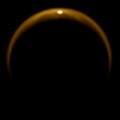Файл:PIA12481 Titan specular reflection.jpg

Памер папярэдняга прагляду: 600 × 600 пікселяў. Іншыя разрозненні: 240 × 240 пікселяў | 480 × 480 пікселяў | 768 × 768 пікселяў.
Арыгінальны файл (768 × 768 кропак, аб’ём файла: 35 KB, тып MIME: image/jpeg)
Гісторыя файла
Націснуць на даце з часам, каб паказаць файл, якім ён тады быў.
| Дата і час | Драбніца | Памеры | Удзельнік | Тлумачэнне | |
|---|---|---|---|---|---|
| актуальн. | 18:29, 12 снежня 2018 |  | 768 × 768 (35 KB) | Kesäperuna | 100% JPEG quality from full quality TIFF. |
| 10:16, 18 снежня 2009 |  | 768 × 768 (14 KB) | WolfmanSF | {{Information |Description={{en|1=This image shows the first flash of sunlight reflected off a lake on Saturn's moon Titan. The glint off a mirror-like surface is known as a specular reflection. This kind of glint was detected by the visual and infrared m |
Выкарыстанне файла
Наступная 1 старонка выкарыстоўвае гэты файл:
Глабальнае выкарыстанне файла
Гэты файл выкарыстоўваецца ў наступных вікі:
- Выкарыстанне ў an.wikipedia.org
- Выкарыстанне ў ar.wikipedia.org
- Выкарыстанне ў ca.wikipedia.org
- Выкарыстанне ў cs.wikipedia.org
- Выкарыстанне ў en.wikipedia.org
- Выкарыстанне ў en.wikinews.org
- Выкарыстанне ў en.wikiversity.org
- Solar System, technical/Titan
- Draft:Original research/Titan
- Astronomy college course/Miranda and Titan
- Astronomy college course/Miranda and Titan/questions
- OpenStax Astronomy/Test 3 Study guide
- Astronomy college course/Unit 3 study guide
- Wright State University Lake Campus/2016-1/Phy1060/T3 upgrade
- Wright State University Lake Campus/2017-1/Phy1060/printPDF
- Wright State University Lake Campus/2019-1/Phy1060/Old studyguide/Pdf
- Quizbank/All questions
- Выкарыстанне ў fr.wikipedia.org
- Выкарыстанне ў gl.wikipedia.org
- Выкарыстанне ў hy.wikipedia.org
- Выкарыстанне ў id.wikipedia.org
- Выкарыстанне ў it.wikipedia.org
- Выкарыстанне ў ja.wikipedia.org
- Выкарыстанне ў ka.wikipedia.org
- Выкарыстанне ў mk.wikipedia.org
- Выкарыстанне ў mwl.wikipedia.org
- Выкарыстанне ў no.wikipedia.org
- Выкарыстанне ў pl.wikipedia.org
- Выкарыстанне ў pt.wikipedia.org
- Выкарыстанне ў ro.wikipedia.org
- Выкарыстанне ў ru.wikipedia.org
- Выкарыстанне ў ta.wikipedia.org
- Выкарыстанне ў ta.wikinews.org
- Выкарыстанне ў uk.wikipedia.org
- Выкарыстанне ў vi.wikipedia.org
- Выкарыстанне ў xmf.wikipedia.org
Паказаць глабальнае выкарыстанне гэтага файла.


